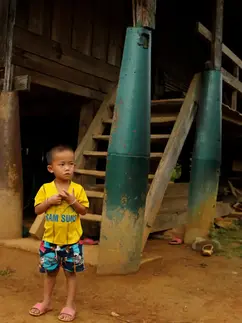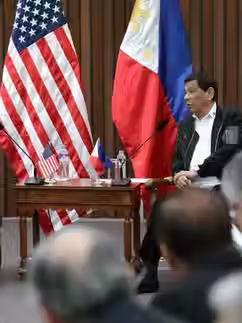The Central Asia-Russia relationship: What’s changed since the Russian invasion of Ukraine?
Lachlan Kappa

The impacts of Russia’s invasion of Ukraine in February 2022 have been felt far and wide, but this is especially true of the former-Soviet Republics of Central Asia, comprising Kazakhstan, Kyrgyzstan, Tajikistan, Turkmenistan, and Uzbekistan. Since the fall of the Soviet Union in 1991, Russia has enjoyed a strong economic and political soft-power position in the bloc, benefiting from their centrally isolated geographic position and continued dependence on Russia for export routes, security, and labour markets.
But two years into the invasion, Russia finds itself more estranged from the international community as ever. This begs the question, how has Russian soft-power projection been impacted with relation to the five Central Asian states? How has the dynamic of the region changed since February 2022?
Unpopular War
Overall, the attitudes towards the Russian invasion of Ukraine in Central Asia is negative. According to the Central Asian Barometer (CAB) Survey Wave 11 conducted between May-June in 2022, 70 per cent of Kyrgyz voters, and 55 per cent of Kazakh voters answered that the War will have some degree of negative impact on their country.
From the wake of the Russian Invasion of Ukraine, and subsequent United Nations General Assembly (UNGA) resolution on March 2 2022, no Central Asian state formally sided with Moscow, instead voting to abstain or were absent (Turkmenistan and Uzbekistan). This trend continued from the March 27 UNGA 11493 on the Territorial integrity of Ukraine, following Russia’s annexation of Crimea in February 2014.
Diplomatic distance
It goes without saying Russia and Central Asia share a deep, and sophisticated political, cultural and historical heritage. This remains true, with a strong linguistic, cultural and economic presence in today’s society. For example, the Moscow-dominated Eurasian Economic Union (EAEU), and the Collective Security Treaty Organisation (CSTO), serve as the most prominent initiatives binding Russia to their Central Asian allies.
However, cracks are appearing, for example, as EAEU refused to accept customs duties from Russia in rubles following the Western imposition of sanctions. The governments of Kazakhstan, Kyrgyzstan and Uzbekistan have generally allowed some anti-war protests, the collection of humanitarian aid goods by civil societies, and suppressed the outward expression of the pro-war “Z” propaganda symbol propagated by supporters of Putin.
In addition, there has been some evidence of firm resistance to Moscow from the Central Asian states. A telephone conversation on February 26, 2022 between President Vladimir Putin and the president of Kyrgyzstan, Sadyr Japarov, resulted in a public statement from Putin thanking Jarapov for “his principled position of solidarity” with Russia. However, the Kyrgyz presidential administration’s readout made no mention of solidarity from Bishkek, only having discussed the “current situation around Ukraine.”
Economic wins and losses
Economically speaking, Central Asia and Moscow are close trading partners. So despite some diplomatic rows, the War in Ukraine has accelerated the trade relationship to some degree since 2022, as states like Kazakhstan reap the benefits of having helped Russia bypass Western sanctions. Krygzstan, Tajikistan and Uzbekistan continue to receive remittances from in-demand migrant workers in Russia, and trade is booming for Kazakh companies exporting electronic equipment to Russia. Between January and October 2022, trade had multiplied by 18 times, as compared to the same period in 2021.
Because of this, Central Asia has been directly warned of the consequences of helping Russia sidestep sanctions, with secondary sanctions imposed by the West not out of the question. As a result, Kyrgyzstan reluctantly banned drone exports to Russia, and Kazakh President Tokayev reassured the International Community that they had straightened out their act.
Since the conflict began, Russia’s economic plummet (due to Western sanctions) directly impacted Central Asian currencies, imports and the welfare of migrant workers prone to conscription. In addition, the price of food stables for EAEU members spiked following Russia’s ban on grain exports to the region.
To remedy this, and their own situation, Russia is actively trying to turn the Central Asian states into energy and petroleum customers, as well as transiters of hydrocarbons to China. At the end of 2022, Putin proposed a gas union with Uzbekistan and Kazakhstan to coordinate the logistics of delivering Russian gas to China through their territories.
Central Asia in Change
The War in Ukraine undermined Moscow’s strategic position globally, and Central Asian states, however they may have benefited from this economically, could also be equally impacted due to proximity. The strategy of maintaining close ties to Russia, and bypassing sanctions, is difficult at best.
The network of relationships in Central Asia is changing, and the five states within it can benefit from more strategic partnerships, with the likes of China, among many. The May 2023 China-Central Asia Summit in Xi’an revealed a strong pathway for strategic advancements in the region. This included the development of the China-Kyrgyzstan-Uzbekistan railway, and the construction of Line D of the Central Asia-China pipeline. The latter of which will transport natural gas from Turkmenistan, Kazakhstan, and Uzbekistan directly to China.
Today, Turkmenistan is China’s single biggest supplier of natural gas, followed by Russia. Enhanced accessibility to large markets in China, and greater connectivity across the region, are a welcomed development for the landlocked nations.
In addition, the September 2023 “C5+1” Summit, i.e. the five Central Asian states, plus the United States, culminated in a Join Statement outlining a symbolic increase in engagement from the US into the region. The Statement reaffirmed US commitments to sovereignty, and greater educational, infrastructural and clean energy investments to fight climate change effects.
Washington had their own attempts to influence the lucrative Central Asian gas markets, through the Turkmenistan-Afghanistan-Pakistan-India gas pipeline project (TAPI), proposed in 2011. These attempts have not resumed with any profound impact since 2022, leaving China on top as the largest customer of Central Asian gas exports.
Similar Summits with the five Central Asian presidents have been held with the additions of France, Germany, India, Pakistan, Iran, Türkiye, and the Cooperation Council for the Arab States of the Gulf (GCC) since 2022, who also want to have their say in the region.
It is yet to be seen to what depth China will influence the region, as the likeliest power (aside from Russia) to have a profound influence. Their developments (ongoing and proposed) align with, and propel China’s outward-reaching and inclusive cooperation models, such as with the Belt and Road Initiative, and the Shanghai Cooperation Organisation. However, China is struggling to leave an ideological footprint in Central Asia, and does not in any way compete with Russia, in terms of historical and cultural significance. This is true even down to the level of public opinion.
A harmful former-Soviet legacy?
Despite pressure from the West to champion sovereignty in the region, and the diplomatic ‘bumps in the road' with Russia, the relationship remains close. The participation of all five Central Asian presidents at the Red Square military parade on May 9 2023 is a small token of their long-standing connection.
Overall, the Russian invasion of Ukraine, and Russia’s authoritarian displays have not deterred Central Asia from engaging closely with them. Authoritarian tendencies and slow democratic advancements have developed uniquely to a Central Asia context since the thirty-two years of independence from the Soviet Union. Each country presents a diverse picture of political values, and has developed under varying conditions and economic landscapes, profoundly influenced from its Soviet past.
Overall, since the beginning of the Russian invasion of Ukraine in 2022, Central Asia has been placed in a precarious position. It remains the centre of a dynamic geostrategic tug-of-war along the modern day Silk Road, serving both the East and West, notably in the field of natural gas.
The Central Asian states, namely Kazakhstan and Turkmenistan, have largely benefited in varying degrees economically and strategically since the beginning of the Russian invasion of Ukraine in 2022. Russia provides an extremely important foundational long-term relationship and connection to large markets with opportunity.
Despite the efforts to diversify its strategic partnerships, many states simply cannot compete with, nor take the regional hegemonic position that Russia fills in Central Asia, despite any small-scale tensions which may have arisen directly from the War.
Russia may be ‘down’, but it is by no means ‘out’ in Central Asia.
Lachlan Kappa graduated from Monash University with a Bachelor of Arts in International Relations, with a strong emphasis on History, Conflict, and French. He currently works in travel risk intelligence as an Asia-Pacific (APAC) Junior Analyst. He aims to gain greater insights into geopolitical issues facing the Post-Soviet and French-speaking worlds.

















Comments